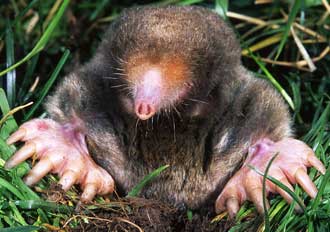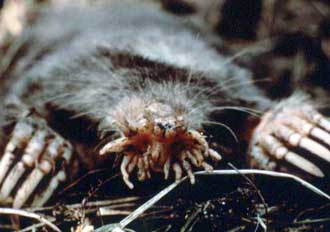Reduce lawn and garden damage caused by moles, skunks and raccoons
What you can do to discourage pests such as moles, skunks and raccoons from digging up your yard and garden.
If you are a gardener or even a semi-serious lawn-tender, wild critters coming into the yard can cause havoc. There are things that a smart gardener can do to lessen damage to the lawn and garden. Let’s be realistic; there is no way to prevent all problems continuously. Each spring, Michigan State University Extension horticulture educators and Master Gardener hotline staff receive many questions on moles, skunks and raccoons damaging the lawn and possible solutions.
Moles
There are two kinds of moles that work under your lawn. The star-nosed mole digs at least 6 inches deep and leaves periodic piles of soil that are air vents. The eastern mole tunnels shallowly and it is possible to follow its trail around the lawn and flower beds. Eighty percent of both moles’ diets are earthworms and the remaining 20 percent is soil insects and grubs. They are not eating plant roots. Moles just leave roots hanging into the empty tunnel to dry out.


(Left) Eastern mole. Photo credit: Kenneth Catania, Vanderbilt University, Wikimedia Commons
(Right) Star-nosed mole. Photo credit: Wikimedia Commons
Mole control is not about grub control in many cases, but it is important to make sure that grubs are not the driving force of your mole invasion. Otherwise, if it is just moles working on that 80 percent of their diet, look at some of the mole repellants that are available. These will only be effective against the eastern mole; the star-nosed mole tunnels are too deep. Many are made with a castor oil extract and are watered into the soil. These make finding food difficult because everything smells unpleasant. There are also baits available. It is important to realize that some types of bait can be ineffective or cause non-target animals such as dogs to dig them up and eat them. If the product can kill a mammal like a mole, it can also kill a curious dog if enough is consumed.
For star-nosed moles, raking the pile of dirt out and dispersing it into the surrounding grass can get rid of the piles. For the eastern mole, buying a lawn roller that becomes heavier by the addition of water can be a real benefit. Add just enough water weight to flatten the tunnels. This is where the grass is likely to die off because of dried out roots. Press grass back into place every couple of days so grass does not die. In flower beds, hand press down soil.
Skunks and raccoons
These two animals will dig in the lawn, especially in the spring and fall looking for grubs, earthworms or soil insects. Having them digging does not mean there are grubs. They eat the same things moles do; they just work from the top down.
Fall is a time to get as fat as possible for the coming winter and spring is a time to put weight back on. Again, it is good to investigate whether there are grubs or not. If less than five grubs per square foot are found, try some of the surface repellants that are castor oil-based. These mask the smell of those sweet treats just below the surface. These can be sprayed on the surface, but are not watered in. Spray the areas that are just adjacent to the damaged areas and any area that has some damage.
Look for my upcoming article on what smart gardeners can do about deer and rabbit prevention.
Related MSU Extension articles



 Print
Print Email
Email